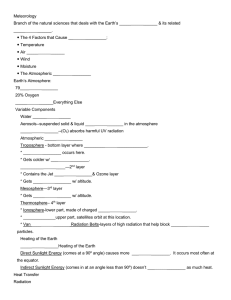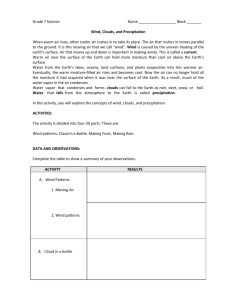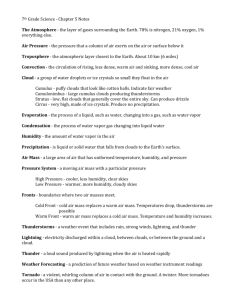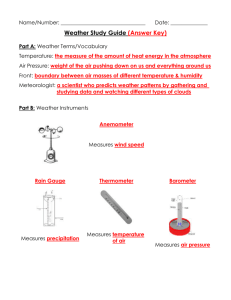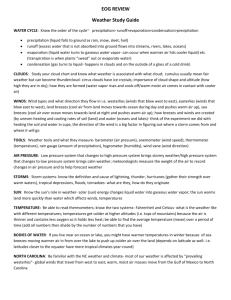Weather - Notes Paper Saver
advertisement
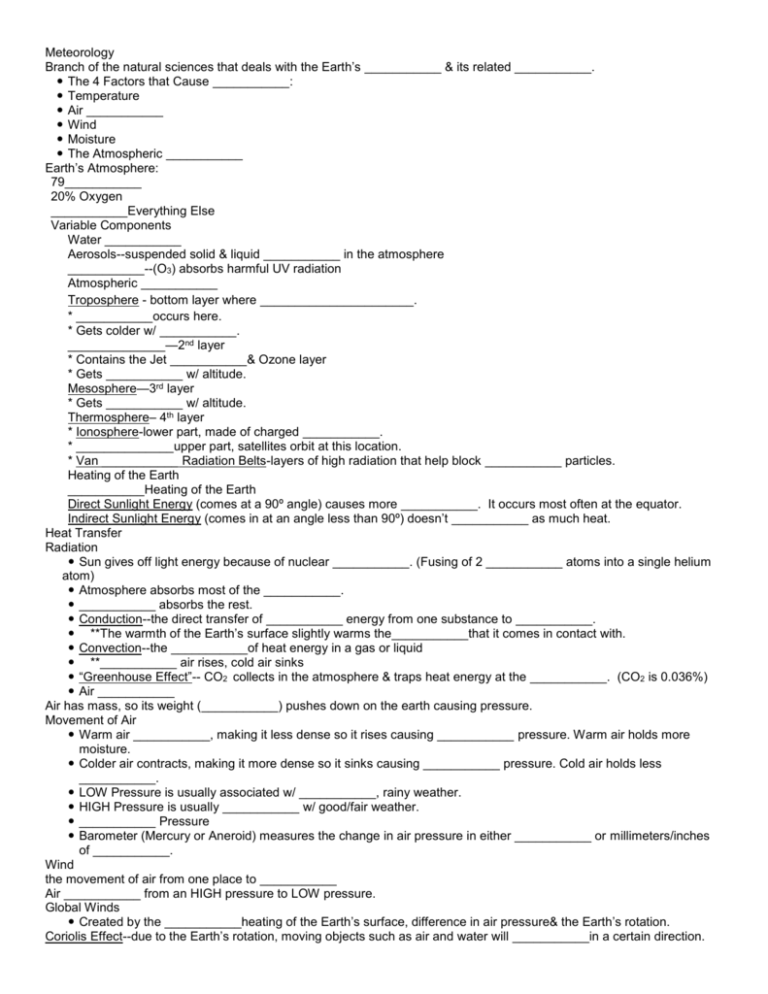
Meteorology Branch of the natural sciences that deals with the Earth’s ___________ & its related ___________. The 4 Factors that Cause ___________: Temperature Air ___________ Wind Moisture The Atmospheric ___________ Earth’s Atmosphere: 79___________ 20% Oxygen ___________Everything Else Variable Components Water ___________ Aerosols--suspended solid & liquid ___________ in the atmosphere ___________--(O3) absorbs harmful UV radiation Atmospheric ___________ Troposphere - bottom layer where ______________________. * ___________occurs here. * Gets colder w/ ___________. ______________—2nd layer * Contains the Jet ___________& Ozone layer * Gets ___________ w/ altitude. Mesosphere—3rd layer * Gets ___________ w/ altitude. Thermosphere– 4th layer * Ionosphere-lower part, made of charged ___________. * ______________upper part, satellites orbit at this location. * Van ___________ Radiation Belts-layers of high radiation that help block ___________ particles. Heating of the Earth ___________Heating of the Earth Direct Sunlight Energy (comes at a 90º angle) causes more ___________. It occurs most often at the equator. Indirect Sunlight Energy (comes in at an angle less than 90º) doesn’t ___________ as much heat. Heat Transfer Radiation Sun gives off light energy because of nuclear ___________. (Fusing of 2 ___________ atoms into a single helium atom) Atmosphere absorbs most of the ___________. ___________ absorbs the rest. Conduction--the direct transfer of ___________ energy from one substance to ___________. **The warmth of the Earth’s surface slightly warms the___________that it comes in contact with. Convection--the ___________of heat energy in a gas or liquid **___________ air rises, cold air sinks “Greenhouse Effect”-- CO2 collects in the atmosphere & traps heat energy at the ___________. (CO2 is 0.036%) Air ___________ Air has mass, so its weight (___________) pushes down on the earth causing pressure. Movement of Air Warm air ___________, making it less dense so it rises causing ___________ pressure. Warm air holds more moisture. Colder air contracts, making it more dense so it sinks causing ___________ pressure. Cold air holds less ___________. LOW Pressure is usually associated w/ ___________, rainy weather. HIGH Pressure is usually ___________ w/ good/fair weather. ___________ Pressure Barometer (Mercury or Aneroid) measures the change in air pressure in either ___________ or millimeters/inches of ___________. Wind the movement of air from one place to ___________ Air ___________ from an HIGH pressure to LOW pressure. Global Winds Created by the ___________heating of the Earth’s surface, difference in air pressure& the Earth’s rotation. Coriolis Effect--due to the Earth’s rotation, moving objects such as air and water will ___________in a certain direction. Global Wind Belts ___________ Winds – winds that blow from east to west on either side of the ___________. Separated by the Doldrums Prevailing ___________ – winds that blow from west to east between 30o & 60o north & south latitudes. Polar Easterlies - winds that blow from east to west in the ___________regions. Jet Stream A narrow ___________ of high pressure wind found in the lower stratosphere. Pushes large air masses across the ___________. Measuring Wind Wind Speed—___________ Wind Direction--Wind Vane Measured in mi/hr, km/hr, and ___________. Moisture Humidity The measure of the amount of water vapor in the ___________. Specific Humidity--measure of the ___________mass of water vapor in a given mass of air. ___________ Humidity--ratio/percentage of the actual amount of water vapor in a given mass of air compared to the maximum amount of water vapor that air can hold at a given ___________. Psychrometer--a type of ___________ that has a wet bulb thermometer & a dry bulb thermometer Dew Point Temperature--the temperature to which air has to be ___________in order to be completely saturated (filled) with ___________. Clouds: Suspended droplets of water that collect on aerosols. -Formation of clouds depend on the amount of moisture & aerosols in the air, the air temperature, & the stability of the air (air pressure.) • Cirrus – high clouds that are thin & ___________. Made of ice crystals. • Stratus – ___________level clouds that have a layered look. • Cumulus – large, fluffy clouds of vertical development. • The prefix ___________is added to the name of clouds formed in the middle cloud layer. • The prefix/suffix nimbus- is added to the name of a cloud that produces ___________. Precipitation Rain Hailstones Form in _______________ clouds Strong winds carry rain drops above the freezing ___________. Rain drops freeze into ice ___________ & fall. ___________ the wind, the larger the hailstone. Sleet Rain freezes into an ice ___________ as it falls through a ___________ of freezing air. Freezing Rain Rain falls to the ___________ and freezes on ___________with the surface. Snow This occurs when cloud droplets freeze in the clouds and stick together forming ___________. Air Masses: a large body of air that is the ___________ throughout Types **Named ___________ on where the air formed, its temperature, and its ___________ Maritime Polar--it forms over the Northern ___________ and Pacific Oceans. *Brings ___________, MOIST air Maritime Tropical--it forms near the equator. It brings ___________, MOIST air. *If it comes in ___________with cooler air from the North, storms will form. Continental Polar--it forms over northern ___________. It brings COLD, DRY air. *Causes extremely ___________ temperatures in the United States. Continental Tropical--it forms over land in Mexico. It brings ___________, DRY air. Fronts: the ___________ where two air masses collide. The front is named for the ___________ air mass. Cold air ___________and replaces a mass of warm air. Fast in speed. Form ___________ clouds. ___________ frontal zone Short, ___________ weather Warm Front: Warm air mass ___________ and moves over a cold air ___________. Slow ___________ ___________ stratus clouds Wide frontal ___________ ___________periods of drizzle Overcast ___________ ___________ Front--neither air mass moves * No bad weather Occluded Front--a cold front ___________ up with a warm front and ___________ it * Weather can be ___________ and the conditions can change. Dry Line: Dry air ___________ moist air. Fast moving Narrow ___________ zone ___________ cumulus clouds Severe weather in most ___________ Severe Weather Weather that can be considered life ___________ and can cause ___________ to buildings Includes thunderstorms, ___________, tornadoes, flooding, hurricanes, etc. ___________ and Warnings Watches – a watch is issued when the conditions for a certain type of ___________ weather are possible, but not necessarily occurring at the ___________. ___________ – a warning is issued in a specific area where a type of severe weather is ___________ at that given moment. Thunderstorms -Fast moving ___________ that can produce strong winds, ___________, heavy rainfall, lightning & tornadoes. Lightning – static electricity caused by the ___________ of electrical charges by the collisions of rain drops & strong winds. -The positive & negative charges seek each other out. When they connect, an ___________discharge occurs creating a lightning ___________. -Thunder – the heat generated by the lightning bolt ___________ the surrounding air causing it to expand so rapidly that it causes a ___________ boom. -Tornadoes ___________ of high speed circulating winds High winds & updrafts ___________ creating a circulating low pressure. The cloud begins to lower below the cloud base (___________ cloud.) The low ___________ extends to the ground picking up dust & debris forming a tornado. -Hurricanes ___________ cyclone that has a low pressure center (eye) with several ___________ thunderstorms & strong winds around it. Start as tropical ___________ over warm water in the oceans. Storm builds ___________ as it travels over the warm water. -Flooding Kills more people in the U.S. than any other type of ___________ weather. ___________ by too much rain over an extended period of time. It causes lakes, ___________, rivers, etc. to overflow. -Flash Flooding Flooding that mainly occurs in ___________ or cities. A rainstorm that ___________ several inches of rain over a short period of time causes it. It is too much for the ground to ___________ up. It causes low lying areas to overflow and rushing water in other ___________.

